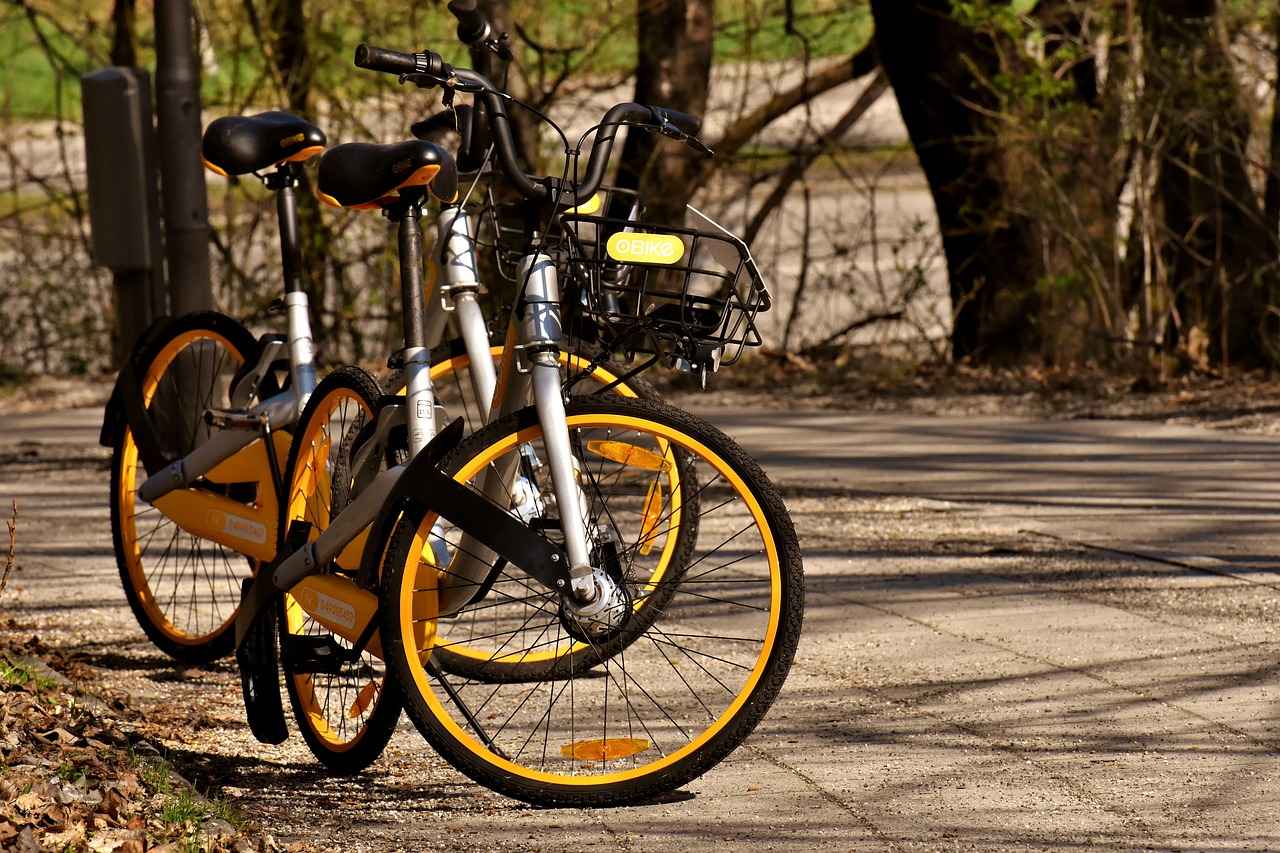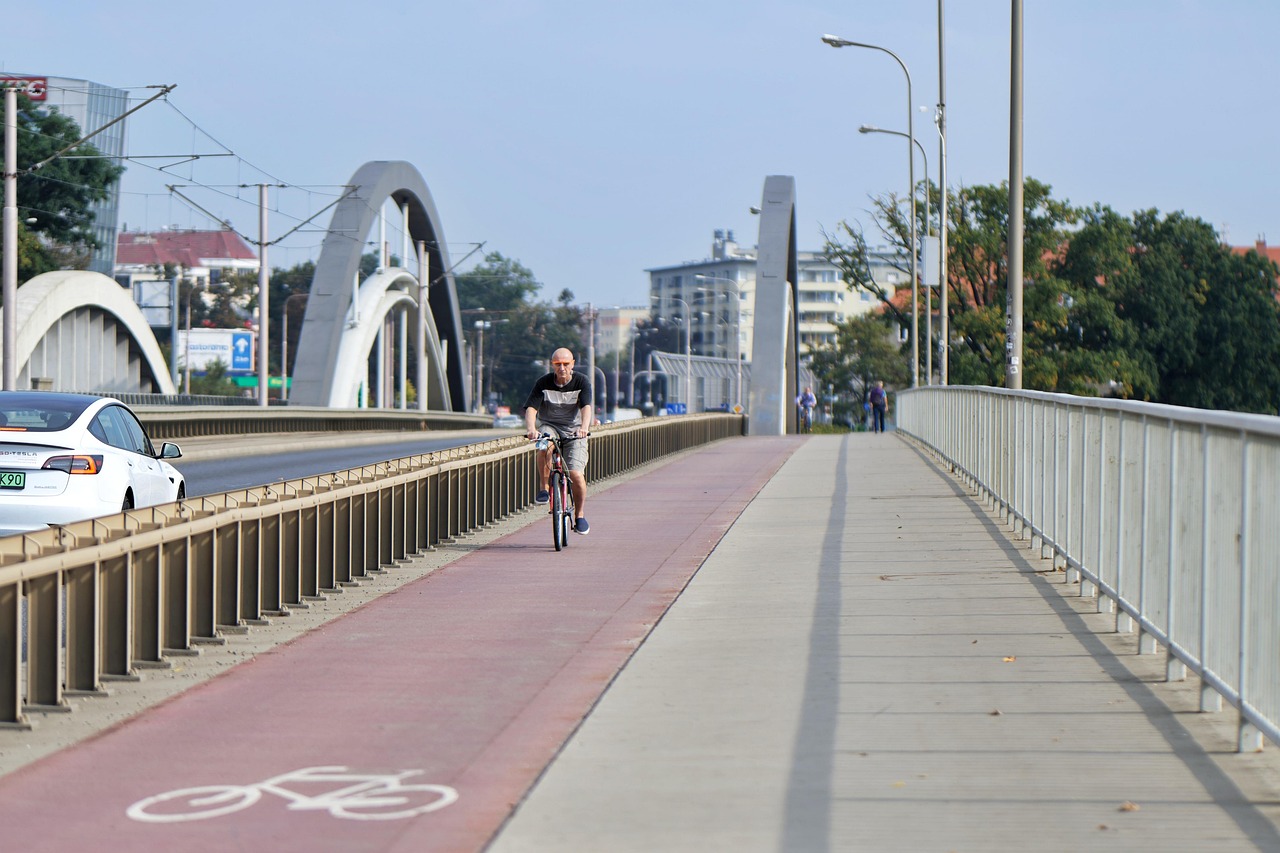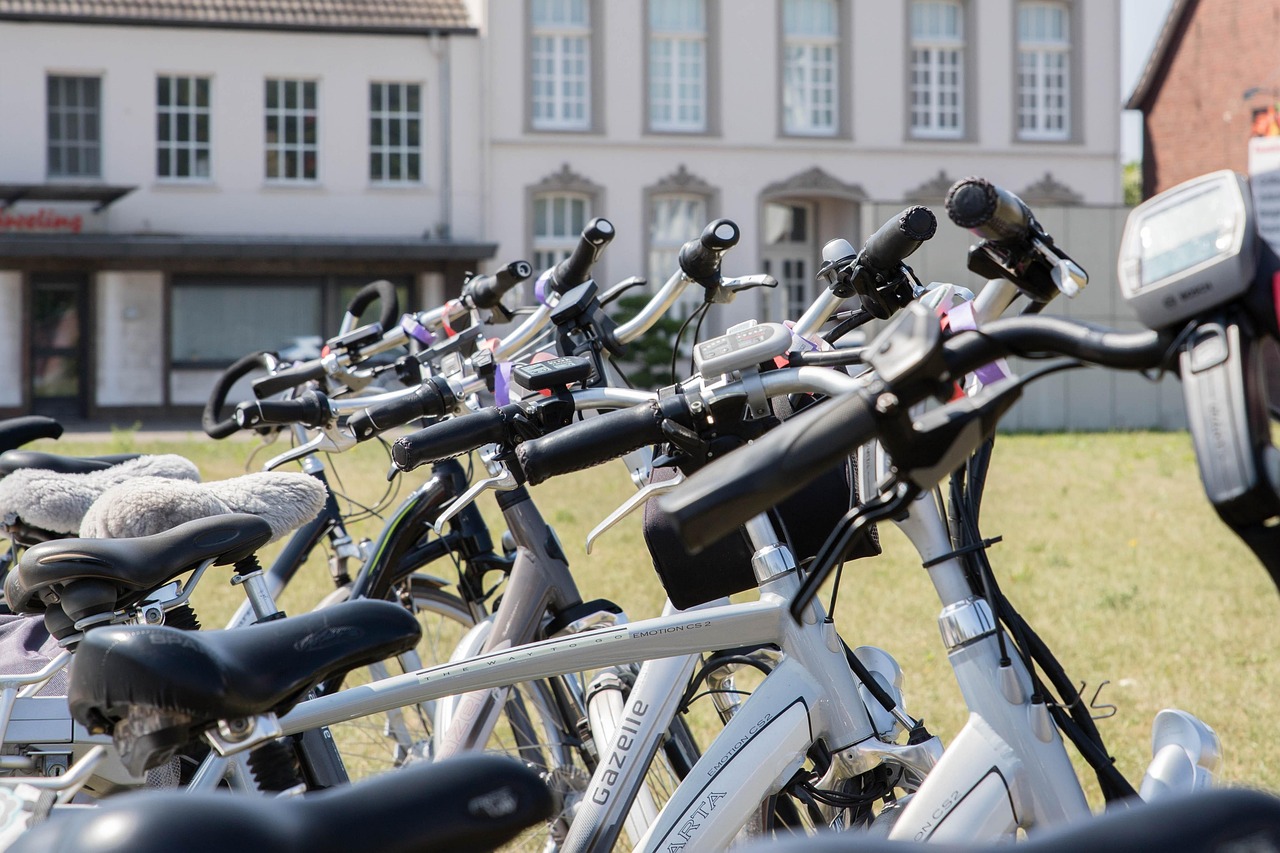This article delves into the myriad of advantages that electric bikes offer for urban commuting. With their efficiency, convenience, and eco-friendliness, electric bikes are rapidly becoming the preferred mode of transportation for city dwellers.
- 1. Eco-Friendly Transportation
Electric bikes significantly lower carbon emissions compared to traditional vehicles. By choosing e-bikes, commuters contribute to a sustainable future and promote greener urban living.
- 2. Cost-Effective Commuting
Switching to electric bikes can lead to substantial savings on fuel, parking, and maintenance costs, making them a budget-friendly alternative for daily travels.
- 3. Health Benefits of Cycling
Electric biking encourages physical activity, enhancing cardiovascular health while providing a less strenuous commuting option.
- 4. Time Efficiency
Electric bikes allow riders to bypass traffic jams, significantly reducing travel time and increasing overall commuting efficiency.
- 5. Convenience and Accessibility
These bikes are easy to park and store, making them ideal for urban environments where space is often at a premium.
- 6. Enhanced Commuting Experience
Modern electric bikes offer a comfortable ride with features like adjustable seating and smooth acceleration, making commutes more enjoyable.
- 7. Safety Features
Equipped with lights and sturdy brakes, electric bikes enhance rider safety, particularly in busy urban settings.
- 8. Community and Social Interaction
Riding electric bikes fosters community among cyclists, encouraging social interactions and connections.
- 9. Customization Options
With various models and accessories available, riders can personalize their electric bikes to suit their commuting needs.
- 10. Future of Urban Transportation
Electric bikes represent a progressive approach to urban transport, aligning with trends towards sustainability and innovative mobility solutions.
Conclusion: Embrace the Electric Bike Revolution
With numerous benefits ranging from environmental impact to personal health, electric bikes are transforming urban commuting. By embracing this trend, individuals can enjoy a more sustainable, efficient, and enjoyable way of navigating city life.

1. Eco-Friendly Transportation
Electric bikes, often referred to as e-bikes, are quickly becoming a popular alternative to traditional vehicles for urban commuting. One of their most significant advantages is their environmental impact. By significantly reducing carbon emissions compared to cars, electric bikes present a sustainable choice for those who are environmentally conscious. In fact, studies show that e-bikes can reduce carbon footprints by up to 50% or more when replacing car trips.
Moreover, the use of electric bikes helps to decrease traffic congestion in urban areas. With more individuals opting for e-bikes over cars, cities can experience less gridlock, leading to quicker travel times for everyone. This shift not only benefits the environment but also promotes a greener urban living experience. As cities evolve, integrating e-bikes into their transportation infrastructure can lead to cleaner air and a more enjoyable commuting experience.
Benefits of Electric Bikes:
- Reduced Carbon Emissions: E-bikes produce zero tailpipe emissions, contributing to cleaner air.
- Less Traffic Congestion: E-bikes take up less space on the road and can navigate through traffic more easily.
- Encouragement of Sustainable Practices: Using e-bikes can inspire more people to consider eco-friendly transportation options.
In conclusion, electric bikes are not just a trend; they represent a vital shift towards sustainable urban transportation. By choosing e-bikes, commuters can play a significant role in promoting environmental sustainability and enhancing the quality of life in their cities.

2. Cost-Effective Commuting
Cost-effective commuting is a significant advantage of adopting electric bikes for urban travel. As fuel prices continue to rise, many commuters are seeking alternatives that do not strain their budgets. Electric bikes emerge as a budget-friendly option, allowing users to save on various expenses associated with traditional vehicles.
One of the most notable savings comes from fuel costs. Electric bikes run on electricity rather than gasoline, which can lead to substantial savings over time. According to recent studies, the cost of charging an electric bike is significantly lower than filling up a gas tank, making it an economical choice for daily commutes.
Parking fees also contribute to the overall cost of commuting. Unlike cars that often require expensive parking spaces, electric bikes can be parked in designated bike racks or even on sidewalks, usually at no cost. This convenience not only saves money but also time spent searching for parking.
Additionally, maintenance costs for electric bikes are generally lower than those for cars. With fewer moving parts and no need for oil changes, electric bikes require less frequent servicing, which translates to lower repair bills. This aspect makes them a smart investment for those looking to minimize their commuting expenses.
Another factor to consider is the initial investment. While the upfront cost of purchasing an electric bike may be higher than a traditional bicycle, the long-term savings on fuel, parking, and maintenance make it a financially sound decision. Many regions also offer incentives and rebates to encourage the adoption of electric bikes, further reducing the initial cost.
In conclusion, when evaluating the cost-effectiveness of commuting options, electric bikes stand out as a viable alternative, offering significant savings on fuel, parking, and maintenance while promoting a healthier lifestyle and a greener environment.
Initial Investment vs. Long-Term Savings
When considering the purchase of an electric bike, many potential buyers are often deterred by the initial cost, which can be significantly higher than that of traditional bicycles or even some used cars. However, a closer examination reveals that these upfront expenses can be offset by considerable long-term savings on various transportation-related costs.
Electric bikes offer numerous financial advantages that can make them a wise investment over time. Here are some key points to consider:
- Fuel Savings: Unlike cars that require gasoline, electric bikes are powered by electricity, which is often much cheaper. This can lead to substantial savings in fuel costs, especially for daily commuters.
- Maintenance Costs: Electric bikes generally require less maintenance than traditional vehicles. With fewer moving parts and no oil changes, riders can expect lower repair bills and less frequent visits to the mechanic.
- Parking Expenses: Finding parking in urban areas can be both challenging and expensive. Electric bikes can be parked in smaller spaces, often for free, saving commuters significant money on parking fees.
- Insurance Costs: Insurance for electric bikes is typically much lower than that for cars. This reduction in insurance premiums contributes to the overall savings associated with owning an electric bike.
- Health Benefits: Regular cycling promotes physical fitness, which can lead to lower healthcare costs over time. A healthier lifestyle reduces the risk of chronic diseases, potentially saving thousands in medical expenses.
Moreover, many governments offer incentives and rebates for purchasing electric bikes, further reducing the initial financial burden. By taking advantage of these programs, the effective cost of an electric bike can be significantly lowered.
In conclusion, while the upfront investment in an electric bike may seem daunting, the potential for long-term savings on fuel, maintenance, parking, and insurance makes it a financially sound decision. For urban commuters looking to enhance their mobility while also being budget-conscious, electric bikes present an attractive option.
Government Incentives and Rebates
play a crucial role in promoting the adoption of electric bikes across various regions. As cities and countries strive to reduce their carbon footprints and encourage sustainable transportation, many have implemented financial incentives that make electric bikes more accessible to the general public.
These incentives often come in the form of tax credits, direct rebates, and subsidized loans aimed at lowering the initial purchase price of electric bikes. For instance, some regions may offer rebates that can cover a significant portion of the bike’s cost, making it an attractive option for potential buyers. This not only helps individuals save money but also promotes a shift towards more eco-friendly transportation methods.
In addition to direct financial incentives, many local governments are investing in infrastructure improvements that support electric bike usage. This includes the development of dedicated bike lanes, charging stations, and secure parking facilities. Such investments create a more conducive environment for cyclists, further encouraging the switch from traditional vehicles to electric bikes.
Moreover, these government initiatives often highlight the long-term benefits of electric bikes, such as reduced air pollution and decreased traffic congestion. By providing financial support, governments aim to foster a culture of cycling that not only benefits individuals but also enhances the overall quality of urban life.
As a result, many potential electric bike owners find themselves in a favorable position to make a purchase, benefiting from both the financial incentives and the growing infrastructure dedicated to cycling. This synergy between government support and community engagement is essential for promoting sustainable transportation solutions.
In conclusion, government incentives and rebates are vital components in the push for electric bike adoption. By making these bikes more affordable and ensuring a supportive infrastructure, governments are paving the way for a greener, more sustainable future.
Comparing Costs with Public Transport
When it comes to commuting, many individuals face the dilemma of choosing between electric bike ownership and public transportation. A thorough analysis reveals that electric bikes often emerge as the more economical choice for daily travel. This section delves into the various financial aspects that make electric biking a favorable alternative.
| Expense Category | Electric Bike | Public Transport |
|---|---|---|
| Initial Purchase Cost | $800 – $3,000 (one-time investment) | $0 – $150 (monthly pass) |
| Monthly Operating Cost | $10 (electricity, maintenance) | $70 – $120 (monthly fare) |
| Parking Costs | Free or minimal | $0 – $50 (parking fees) |
While the initial investment in an electric bike may seem daunting, it is crucial to consider the long-term savings. With public transportation fares increasing annually, the cumulative costs of commuting by bus or train can quickly surpass the one-time expense of purchasing an electric bike.
- Fuel Savings: Electric bikes run on electricity, which is significantly cheaper than gasoline.
- Maintenance Costs: Electric bikes require less upkeep compared to cars, further reducing overall expenses.
- Time Savings: Biking can often be faster than public transport, especially in congested urban areas, saving both time and money.
Moreover, many cities offer incentives for electric bike purchases, such as tax rebates or subsidies, which can further offset the initial costs. In contrast, public transport systems rarely provide such financial benefits.
In conclusion, when comparing costs, electric bikes not only provide a more affordable commuting option but also contribute to a healthier lifestyle and a greener environment. With the rising costs of public transport and the numerous advantages of electric biking, it is clear that investing in an electric bike is a wise choice for urban commuters.
Maintenance and Repair Costs
are crucial factors to consider when evaluating transportation options, particularly in urban settings. Electric bikes (e-bikes) have emerged as a preferred choice for many city commuters, and one of the standout advantages they offer is their lower maintenance requirements compared to traditional vehicles like cars.
Unlike cars, which necessitate regular oil changes, complex engine repairs, and expensive parts replacements, e-bikes are designed with simplicity in mind. The absence of a combustion engine means fewer moving parts, which translates to reduced wear and tear. Here’s a breakdown of why e-bikes are more cost-effective:
- Minimal Mechanical Issues: E-bikes primarily rely on electric components, which generally require less frequent servicing.
- Fewer Repairs: The likelihood of encountering mechanical failures is significantly lower, as e-bikes do not have intricate systems like those found in cars.
- Affordable Parts: When repairs are necessary, e-bike parts tend to be less expensive than automotive parts, leading to lower overall repair costs.
In addition to reduced maintenance costs, e-bikes also promote fewer trips to the mechanic. This not only saves money but also enhances convenience for riders. Commuters can enjoy the freedom of a hassle-free experience, allowing them to focus more on their journeys instead of worrying about mechanical issues.
Moreover, many e-bike models come with warranties that cover essential components, providing an extra layer of financial protection for users. This assurance further emphasizes the affordability and reliability of electric bikes as a commuting option.
In conclusion, the associated with electric bikes are significantly lower than those of cars, making e-bikes a compelling choice for urban commuters seeking a budget-friendly and efficient mode of transportation.

3. Health Benefits of Cycling
Riding an electric bike is not just a fun way to get around; it also offers numerous health benefits that can significantly enhance your physical and mental well-being. Here, we explore how electric biking can be a game-changer for your health.
- Promotes Physical Activity: Unlike traditional commuting methods, electric biking encourages you to engage in physical activity. The pedal-assist feature allows riders to choose how much effort they want to exert, making it easier to incorporate cycling into daily routines.
- Improves Cardiovascular Health: Regular cycling strengthens the heart and lungs. Studies have shown that consistent biking can lead to improved cardiovascular function and reduced risk of heart diseases. Even short rides can contribute to better heart health.
- Boosts Overall Fitness: Electric biking can help tone muscles, particularly in the legs and core, while also enhancing endurance. This form of exercise is particularly beneficial for those who may find traditional cycling too strenuous.
- Mental Health Benefits: Cycling has been shown to alleviate symptoms of anxiety and depression. The combination of physical activity and exposure to the outdoors can significantly enhance mood and mental clarity.
- Weight Management: Regular electric biking can aid in weight management by burning calories. It allows individuals to maintain a healthy weight without the high-impact stress associated with other forms of exercise.
In summary, riding an electric bike promotes a more active lifestyle, improves cardiovascular health, and enhances overall fitness while providing a less strenuous commuting option. By integrating electric biking into your daily routine, you can enjoy these health benefits while also contributing to a more sustainable environment.
Cardiovascular Health Improvement
Cardiovascular health is a vital aspect of overall well-being, and engaging in regular physical activities such as cycling plays a crucial role in enhancing it. Cycling, whether on a traditional or electric bike, provides a fantastic cardiovascular workout that can lead to numerous health benefits.
When you cycle, your heart rate increases, which helps to strengthen your heart muscle. This improvement in heart function can lead to better blood circulation and lower blood pressure, reducing the risk of heart disease. Moreover, cycling is an aerobic exercise that boosts lung capacity and efficiency, allowing your body to utilize oxygen more effectively.
- Improved Heart Function: Regular cycling can lead to a stronger heart, enabling it to pump blood more efficiently.
- Lower Risk of Chronic Diseases: Engaging in cycling reduces the risk of conditions such as diabetes, hypertension, and heart disease.
- Enhanced Lung Capacity: Cycling increases lung capacity, promoting better oxygen intake and overall respiratory health.
Furthermore, the low-impact nature of cycling makes it accessible to a wide range of individuals, including those who may have joint issues or are new to exercise. This inclusivity encourages more people to adopt cycling as part of their daily routine, leading to improved public health.
Incorporating cycling into your lifestyle not only enhances physical fitness but also contributes positively to mental health. The release of endorphins during cycling can help alleviate stress and anxiety, fostering a healthier mindset.
In conclusion, regular cycling is a powerful tool for improving cardiovascular health. By promoting heart and lung strength while reducing the risk of chronic diseases, cycling serves as an enjoyable and effective form of exercise that benefits both physical and mental well-being.
Mental Health Benefits
In today’s fast-paced world, maintaining mental health is more crucial than ever. One effective way to enhance mental well-being is through regular cycling. Numerous studies have shown that engaging in physical activities, particularly cycling, can lead to significant reductions in stress and anxiety levels.
Stress Reduction
Cycling is an excellent way to clear your mind and escape daily stressors. The rhythmic motion of pedaling combined with the fresh air can create a meditative effect, allowing individuals to focus on the present moment rather than their worries. Moreover, the release of endorphins during physical activity can elevate mood and promote a sense of happiness.
Combatting Anxiety
For those struggling with anxiety, cycling can serve as a powerful coping mechanism. The focus required to navigate through traffic or enjoy a scenic route can distract from anxious thoughts. Additionally, the sense of accomplishment after a ride can enhance self-esteem and provide a positive outlook on life.
Improved Sleep Quality
Regular cycling can contribute to better sleep patterns. Physical activity helps regulate the body’s circadian rhythm, leading to deeper and more restful sleep. Improved sleep quality can further alleviate symptoms of anxiety and stress, creating a positive feedback loop for mental health.
Social Connections
Cycling can also foster social interactions, which are vital for mental well-being. Joining cycling clubs or participating in group rides can lead to new friendships and a sense of community. These social connections can provide emotional support and decrease feelings of loneliness.
Conclusion
Incorporating cycling into your daily routine can significantly enhance mental health. From reducing stress and anxiety to improving sleep quality and fostering social connections, the benefits are extensive. Embracing cycling not only promotes physical fitness but also nurtures a healthier mind.

4. Time Efficiency
Time Efficiency is a crucial factor for urban commuters, especially in bustling city environments where traffic congestion can significantly impact travel times. Electric bikes have emerged as a popular solution for those looking to optimize their daily commutes. Here are some key points highlighting how electric bikes enhance time efficiency for city dwellers:
- Bypassing Traffic Congestion: Unlike traditional vehicles, electric bikes can easily navigate through narrow streets and utilize dedicated bike lanes. This ability allows riders to bypass gridlock, resulting in significantly shorter travel times during peak hours.
- Flexible Route Options: Electric bike riders have the freedom to choose from various routes, including scenic paths and shortcuts. This flexibility not only makes the journey more enjoyable but also allows for quicker access to destinations.
- Reduced Waiting Times: Commuting by electric bike eliminates the need to wait for public transport or deal with the hassle of finding parking. Riders can simply hop on their bikes and go, reducing overall commute times.
- Consistent Travel Speeds: Electric bikes can maintain higher average speeds compared to traditional cycling, thanks to their motor assistance. This consistent speed helps riders arrive at their destinations faster, even when faced with inclines or headwinds.
In conclusion, electric bikes represent an efficient commuting option for urban residents seeking to save time and avoid the frustrations of traffic. With their ability to navigate through congested areas and offer flexible route choices, electric bikes are paving the way for a more efficient urban transportation system.
Bypassing Traffic Congestion
is one of the most significant advantages of using electric bikes in urban environments. In cities where traffic jams are a daily occurrence, electric bikes offer a practical solution for commuters seeking to save time and reduce stress.
With their ability to maneuver through narrow streets and utilize dedicated bike lanes, electric bikes enable riders to avoid gridlock effectively. This flexibility not only enhances the commuting experience but also leads to a noticeable reduction in travel time. In fact, studies have shown that electric bike users can often reach their destinations up to 50% faster than those relying on cars or public transport during peak hours.
Moreover, the environmental impact of this mode of transport cannot be overlooked. By choosing to ride an electric bike, commuters contribute to lower traffic congestion, which in turn helps decrease air pollution and carbon emissions in urban areas. This dual benefit of saving time while promoting eco-friendliness makes electric bikes an attractive option for city dwellers.
- Flexible Route Options: Riders can select from various routes, including scenic paths and shortcuts, making their journey not only faster but also more enjoyable.
- Reduced Stress: Avoiding traffic jams leads to a more relaxed commuting experience, allowing riders to arrive at their destinations in a better frame of mind.
- Health Benefits: The physical activity involved in cycling contributes to overall health, making electric bikes a smart choice for those looking to incorporate exercise into their daily routine.
In conclusion, the ability to bypass traffic congestion is a game-changer for urban commuters. Electric bikes not only save time but also promote a healthier lifestyle and a cleaner environment. As more people recognize these benefits, the adoption of electric bikes is likely to continue to rise, transforming the way we navigate our cities.
Flexible Route Options
When it comes to commuting in urban environments, offer riders a unique advantage. Electric bikes provide the ability to choose from a variety of paths, allowing for a customized journey that suits individual preferences and needs.
Riders can select from scenic routes that enhance their riding experience, providing beautiful views and a refreshing atmosphere. These paths often meander through parks, along riversides, or through vibrant neighborhoods, making the commute not just a necessity, but an enjoyable part of the day.
In addition to scenic paths, electric bike users can also opt for shortcuts that help them reach their destinations more quickly. These routes can be particularly beneficial during peak traffic hours, as they allow riders to bypass congested streets and arrive at their destinations in a timely manner. This flexibility can significantly reduce the stress associated with commuting, as riders can adapt their routes based on real-time traffic conditions.
Moreover, the ability to choose different routes promotes a sense of adventure and exploration. Commuters can discover new areas of their city, stop at local cafes, or even meet friends along the way. This exploratory aspect of riding an electric bike encourages a more engaged and active lifestyle, making daily commutes feel less monotonous.
| Route Type | Benefits |
|---|---|
| Scenic Paths | Enhances the riding experience with beautiful views |
| Shortcuts | Reduces travel time and avoids traffic congestion |
| Exploratory Routes | Encourages discovering new places and social interactions |
In conclusion, the flexibility in route options offered by electric bikes not only makes commuting more efficient but also enriches the overall experience for riders. By choosing paths that align with their preferences, commuters can transform their daily travels into enjoyable journeys.

5. Convenience and Accessibility
Convenience and Accessibility are critical factors when considering transportation options in urban environments. Electric bikes stand out as a practical solution, especially for city dwellers who often face space constraints and the need for efficient commuting methods.
One of the key advantages of electric bikes is their compact design. Unlike traditional bicycles or cars, electric bikes can be easily stored in small spaces, such as apartments or bike racks, making them an ideal choice for urban living. This is particularly beneficial in cities where parking can be a hassle and space is at a premium.
- Easy Parking Solutions: Finding a parking spot for an electric bike is generally simpler than for a car. Riders can park closer to their destinations, saving time and avoiding the frustration of searching for a parking space.
- Lightweight and Portable: Many electric bikes are designed to be lightweight, allowing for easy transport. This portability means that if you need to take your bike inside a building or on public transport, it won’t be a cumbersome task.
Additionally, electric bikes often come equipped with features that enhance their accessibility. For instance, adjustable seats and handlebars cater to riders of different heights, ensuring a comfortable ride for everyone. Moreover, many models include step-through frames that make it easier to mount and dismount, particularly for those with mobility challenges.
In urban areas where traffic congestion is a daily frustration, electric bikes provide a flexible commuting option. Riders can choose various routes, including bike lanes and scenic paths, which not only makes commuting more enjoyable but also allows for quicker travel times compared to cars stuck in traffic.
In conclusion, the convenience and accessibility of electric bikes make them a practical choice for urban transportation. With their ability to navigate tight spaces, easy parking solutions, and lightweight designs, electric bikes offer a viable alternative for city dwellers looking to enhance their commuting experience.
Easy Parking Solutions
Finding parking for electric bikes is generally easier than for cars, allowing commuters to park closer to their destinations without the hassle of searching for parking spots. This convenience is one of the many reasons why electric bikes are becoming increasingly popular among urban dwellers.
Unlike traditional vehicles, electric bikes can be parked in designated bike racks, which are often located in prime areas near shops, offices, and public transport stations. This accessibility not only saves time but also reduces the stress associated with finding a parking space. Here are some advantages of parking electric bikes:
- Proximity to Destinations: Electric bikes can be parked much closer to your final destination compared to cars, which often require parking in distant lots.
- Less Competition: With fewer bikes than cars on the road, finding a spot to park is usually straightforward, especially in busy urban environments.
- Cost-Effective Parking: Many cities offer free or low-cost parking for bicycles, making it a more economical option compared to expensive car parking fees.
- Reduced Traffic Congestion: As more people opt for electric bikes, there is less traffic congestion, which in turn makes parking easier for everyone.
Additionally, many electric bike manufacturers are now creating bikes that are lightweight and portable, allowing riders to carry them into buildings or stores if necessary. This feature further enhances the convenience of commuting by electric bike.
In conclusion, the ease of parking electric bikes not only contributes to a smoother commute but also encourages more people to consider this eco-friendly mode of transportation. As cities continue to adapt to the growing popularity of electric bikes, we can expect even more improvements in infrastructure and parking solutions, making urban commuting more efficient and enjoyable.
Portable and Lightweight Designs
are one of the most appealing features of modern electric bikes, especially for urban commuters. In bustling city environments, where space is often at a premium, having a bike that is easy to carry and store can significantly enhance the commuting experience.
Many electric bikes are designed with lightweight materials such as aluminum or carbon fiber, which not only reduce the overall weight but also maintain structural integrity. This design philosophy allows riders to effortlessly maneuver their bikes in crowded areas or carry them up stairs when necessary. For example, some models weigh as little as 30 pounds, making them comparable to traditional bicycles.
Moreover, the foldable designs of certain electric bikes add another layer of convenience. These bikes can be easily collapsed and stored in compact spaces like closets or under desks, making them ideal for those living in small urban apartments. This portability ensures that riders can take their bikes on public transport without hassle, further enhancing their commuting flexibility.
In addition to being easy to carry, lightweight electric bikes often feature ergonomic designs that promote comfort during rides. Many models come equipped with adjustable seats and handlebars, allowing users to customize their riding position for optimal comfort. This is especially beneficial during longer commutes, where comfort can significantly impact the overall experience.
For those who are concerned about the battery life, many lightweight electric bikes are engineered to be energy-efficient. This means that even with a smaller battery, riders can achieve substantial distances without the need for frequent recharging, making them a practical choice for daily use.
In conclusion, the of electric bikes cater to the needs of urban commuters by providing convenience, comfort, and efficiency. As more people recognize the benefits of these innovative designs, the popularity of electric bikes is likely to continue to grow, transforming the way we navigate our cities.

6. Enhanced Commuting Experience
When it comes to urban commuting, electric bikes stand out by providing a comfortable and enjoyable riding experience. With their innovative design and technology, these bikes cater to the needs of city dwellers who seek efficiency without sacrificing comfort.
- Adjustable Seating: Many electric bikes come with adjustable seats that allow riders to find their perfect height and angle, ensuring a more ergonomic posture during rides. This feature minimizes discomfort, especially on longer journeys.
- Smooth Acceleration: The electric motor provides a seamless acceleration experience, allowing riders to easily navigate through busy streets without the jarring starts and stops typical of traditional bicycles.
- Hill Climbing Made Easy: One of the standout features of electric bikes is their ability to tackle hills effortlessly. The electric assist helps riders conquer steep inclines without excessive physical exertion, making commutes more manageable.
In addition to these features, electric bikes often include:
- Cushioned Seats: Many models are equipped with padded seats designed for comfort, reducing fatigue during longer rides.
- Weather Protection: Some electric bikes come with accessories like fenders and windshields, allowing riders to stay dry and comfortable in varying weather conditions.
- Integrated Technology: Features such as built-in GPS and smartphone connectivity enhance the overall riding experience, making navigation easier and more efficient.
Overall, the enhanced commuting experience offered by electric bikes not only makes daily travel more pleasant but also encourages more people to opt for cycling as a viable mode of transportation in urban settings.
Comfort Features
are a crucial aspect of modern electric bikes, significantly enhancing the riding experience for commuters. As urban dwellers increasingly turn to electric bikes for their daily transportation needs, manufacturers have prioritized comfort in their designs. This article delves into the various features that contribute to a more enjoyable and comfortable ride.
| Comfort Feature | Description |
|---|---|
| Cushioned Seats | Electric bikes often come with well-padded, ergonomic seats that provide support during long rides, reducing discomfort and fatigue. |
| Adjustable Handlebars | Many models feature adjustable handlebars, allowing riders to customize their riding position for better control and comfort. |
| Shock Absorption Systems | Advanced suspension systems help absorb bumps and uneven surfaces, ensuring a smoother ride on city streets. |
| Ergonomic Designs | These designs promote a natural riding posture, reducing strain on the back and wrists during longer commutes. |
| Weather Protection Accessories | Many electric bikes can be equipped with fenders and weather-resistant gear, allowing riders to stay comfortable in various weather conditions. |
In addition to these features, electric bikes often include intuitive controls and user-friendly interfaces that enhance the overall riding experience. Riders can easily adjust settings for pedal assist levels, monitor battery life, and track their speed, all of which contribute to a more enjoyable commute.
Furthermore, the integration of technology in modern electric bikes has led to the development of smart features such as GPS navigation and connectivity with mobile apps. These innovations not only improve comfort but also ensure that riders can navigate urban environments more effectively.
In conclusion, the emphasis on comfort in modern electric bikes makes them an ideal choice for city commuting. With features designed to enhance the riding experience, these bikes allow commuters to travel longer distances with ease and enjoyment.
Weather Protection Options
are essential for electric bike riders who wish to maintain comfort and safety while commuting in varying weather conditions. Many modern electric bikes come equipped with weather-resistant features or accessories that enhance the riding experience, allowing cyclists to brave the elements without discomfort.
These features can include:
- Waterproof Materials: Many electric bikes utilize waterproof fabrics and coatings in their construction, ensuring that riders stay dry during rain showers.
- Fenders: These accessories help to prevent water and mud from splashing onto the rider, keeping clothes clean and dry.
- Windshields: Some models offer optional windshields that protect riders from cold winds, making commutes more comfortable during chilly weather.
- Heated Grips: For those who ride in colder climates, heated grips can provide warmth to the hands, improving comfort and control.
- Reflective Materials: Enhanced visibility through reflective elements is crucial for safety, especially during inclement weather or low-light conditions.
Furthermore, riders can also invest in additional accessories such as:
- Waterproof Bags: These are perfect for transporting personal items without the fear of water damage.
- Rain Covers: Specialized covers can protect the bike’s electrical components during heavy rainfall.
In summary, the integration of in electric bikes not only enhances the overall commuting experience but also encourages riders to use their bikes year-round. With the right features, cyclists can confidently navigate through rain, snow, or wind, making electric bikes a versatile and practical choice for urban transportation.

7. Safety Features
When it comes to urban commuting, rider safety is a top priority. Electric bikes are designed with a range of advanced safety features that significantly enhance the overall riding experience, particularly in busy city environments. These features not only protect the rider but also promote a safer atmosphere for all road users.
| Safety Feature | Description |
|---|---|
| Integrated Lights | Most electric bikes come with built-in lights that improve visibility during nighttime rides, ensuring that cyclists can be seen by drivers and pedestrians alike. |
| Reflective Materials | Reflective elements on the bike’s frame and gear enhance visibility in low-light conditions, making it safer to ride at dawn or dusk. |
| Sturdy Brakes | Electric bikes are equipped with high-quality braking systems, including disc brakes, which provide reliable stopping power even in wet or slippery conditions. |
| Wider Tires | Many electric bikes feature wider tires that improve traction and stability, allowing riders to maintain better control, especially on uneven surfaces. |
| Advanced Stability Control | Some models include technology that helps maintain balance, providing an extra layer of safety for riders navigating through traffic. |
In addition to these features, electric bikes often come with smart technology that can alert riders to potential hazards. For instance, some models are equipped with sensors that detect obstacles or changes in road conditions, providing real-time feedback to the cyclist.
Furthermore, wearing appropriate safety gear, such as helmets and reflective clothing, complements the bike’s built-in safety features. This combination greatly reduces the risk of accidents and injuries, making electric bikes a wise choice for urban commuting.
In conclusion, the advanced safety features of electric bikes not only enhance the riding experience but also contribute to a safer urban commuting environment. By prioritizing safety, riders can enjoy the benefits of electric biking with confidence.
Improved Visibility
In urban environments, safety is a primary concern for cyclists, especially during nighttime or low-light conditions. Electric bikes are designed with integrated lights and reflective elements that significantly enhance visibility, making them a safer choice for riders. The combination of these features not only helps cyclists see the road ahead but also ensures that they are easily seen by motorists and pedestrians.
Many electric bikes come equipped with powerful LED lights that can illuminate the path effectively, allowing riders to navigate through dimly lit streets with confidence. These lights often have multiple settings, including steady and flashing modes, to adapt to different riding conditions. The reflective materials used in the bike’s frame and accessories further amplify visibility, reflecting light from vehicles and street lamps, which is crucial for nighttime riding.
Moreover, the strategic placement of lights on electric bikes ensures that they are visible from various angles. This is particularly important in busy urban settings where traffic congestion is common, and visibility can be compromised. Riders can feel more secure knowing that they are equipped with the necessary tools to be seen by others on the road.
In addition to lights, many electric bikes are designed with wider tires that provide better stability and control. This feature is especially beneficial when navigating through busy city traffic, as it enhances the rider’s ability to maneuver safely. The overall design of electric bikes, combined with their safety features, creates a holistic approach to rider safety.
In conclusion, the improved visibility offered by electric bikes through integrated lights and reflective elements plays a vital role in enhancing rider safety. Whether commuting to work or enjoying a leisurely ride, these features ensure that cyclists can navigate urban landscapes confidently and securely.
Stability and Control
are paramount when it comes to riding electric bikes, especially in bustling urban environments. The design of electric bikes often incorporates features that significantly enhance the rider’s experience, making them a preferred choice for city commuters.
One of the most notable aspects of electric bikes is their wider tires. These tires provide a larger contact surface with the ground, which translates to improved grip and stability. This is particularly beneficial when navigating through busy city traffic, where quick maneuvers may be required to avoid obstacles or sudden stops.
Additionally, electric bikes are engineered with better weight distribution. This design feature ensures that the bike remains balanced, even when carrying additional loads such as groceries or a backpack. A well-balanced bike allows for smoother handling and reduces the risk of tipping over, which is crucial when riding in crowded areas.
| Feature | Benefit |
|---|---|
| Wider Tires | Enhances grip and stability on various surfaces |
| Better Weight Distribution | Improves balance and handling, especially with loads |
| Advanced Suspension Systems | Increases comfort and control over uneven terrain |
Moreover, many electric bikes come equipped with advanced suspension systems. These systems absorb shocks and bumps, providing a smoother ride even on rough city roads. This added comfort allows riders to maintain better control, especially during longer commutes or when navigating potholes and curbs.
In summary, the combination of wider tires, improved weight distribution, and advanced suspension systems contributes to the overall of electric bikes. These features not only enhance the safety of the rider but also make the commuting experience more enjoyable. As urban areas continue to grow and traffic congestion increases, the demand for reliable and stable transportation options like electric bikes is likely to rise.

8. Community and Social Interaction
Community and Social Interaction
Riding electric bikes not only serves as a mode of transportation but also fosters a vibrant sense of community among cyclists. In urban environments where social interactions can sometimes feel scarce, electric biking creates opportunities for connections and shared experiences among riders.
Joining Local Cycling Groups
Many cities have established cycling clubs or groups specifically for electric bike enthusiasts. These clubs often organize regular rides, events, and meet-ups, allowing riders to connect with like-minded individuals who share a passion for cycling. Participating in these groups can enhance the overall cycling experience by promoting camaraderie and mutual support.
Encouraging a Cycling Culture
As electric bikes gain popularity, they contribute to the development of a stronger cycling culture within urban areas. This shift encourages local governments to invest in better cycling infrastructure, such as dedicated bike lanes and secure parking facilities. Consequently, more people are likely to embrace cycling as a primary mode of transport, further enhancing community ties.
Social Events and Rides
- Organized Rides: Many communities host group rides that allow electric bike users to explore the city together.
- Charity Events: Participating in charity rides not only promotes fitness but also fosters a spirit of giving and collaboration among cyclists.
- Workshops and Maintenance Classes: These events provide opportunities for cyclists to learn about bike maintenance and safety while meeting fellow riders.
Building Lasting Friendships
Through regular interactions during rides and events, cyclists often form lasting friendships that extend beyond biking. This social network can provide support, motivation, and encouragement, making cycling a more enjoyable and fulfilling activity.
Conclusion
In conclusion, the electric bike community is not just about transportation; it is about creating connections, promoting a healthy lifestyle, and building a supportive network. Embracing the electric bike culture can lead to enriched social interactions and a sense of belonging in the bustling urban landscape.
Joining Cycling Groups
is an excellent way for electric bike enthusiasts to connect, share experiences, and participate in organized events. Many cities have established vibrant cycling communities that cater to riders of all skill levels, providing a platform for social interaction and shared passion.
These groups often organize regular rides, workshops, and events that not only promote cycling culture but also enhance skills and knowledge about electric bikes. Here are some key benefits of joining a cycling group:
- Networking Opportunities: Meeting other riders can lead to lasting friendships and connections within the cycling community.
- Skill Development: Participating in group rides allows members to learn from more experienced cyclists, improving their riding techniques and safety practices.
- Motivation and Accountability: Riding with a group can provide encouragement, making it easier to stick to a regular cycling routine.
- Access to Events: Many cycling groups host events such as charity rides, races, and social gatherings, offering fun ways to engage with the community.
- Advocacy for Cycling Infrastructure: Cycling groups often advocate for better cycling infrastructure and policies, contributing to a more bike-friendly city.
Moreover, joining a cycling group can help foster a sense of belonging among riders. As electric bikes gain popularity, these groups are becoming more inclusive, welcoming individuals from diverse backgrounds and experiences. Whether you are a casual rider or a serious cyclist, there is likely a group that fits your interests and goals.
In conclusion, is a fantastic way to enhance your electric biking experience. It provides not only a community of like-minded individuals but also opportunities for personal growth and advocacy in promoting cycling as a viable urban transportation option.
Encouraging a Cycling Culture
As the popularity of electric bikes continues to rise, cities are witnessing a transformative shift towards a more robust cycling culture. This transition is not just about the bikes themselves; it encompasses a broader movement that promotes healthier lifestyles, sustainable transportation, and community engagement.
1. Increased Adoption of Electric Bikes
With more individuals opting for electric bikes, urban areas are becoming more bike-friendly. This surge in adoption encourages local governments to invest in cycling infrastructure, such as dedicated bike lanes and secure parking facilities. As a result, commuting by bike becomes a safer and more attractive option for everyone.
2. Improved Infrastructure
As cities recognize the growing number of cyclists, they are motivated to enhance their infrastructure. This includes:
- Building more bike lanes
- Implementing bike-sharing programs
- Creating safe and accessible bike parking areas
These improvements not only benefit electric bike riders but also encourage traditional cyclists, leading to a significant increase in overall cycling activity.
3. Policy Changes Favoring Cyclists
With a stronger cycling culture, cities are more likely to adopt bike-friendly policies. This can include:
- Incentives for electric bike purchases
- Tax breaks for businesses that support cycling
- Regulations that prioritize cyclists in urban planning
Such policies create a supportive environment for cyclists, making it easier and more appealing for residents to choose biking as their primary mode of transport.
4. Community Engagement and Events
Electric bike adoption also fosters community engagement through events like cycling festivals and group rides. These gatherings not only promote cycling but also strengthen community bonds, bringing together individuals who share a passion for biking.
Conclusion
As electric bikes gain traction, the resulting cultural shift towards cycling can lead to healthier communities, reduced traffic congestion, and a more sustainable urban environment. By embracing this change, cities can pave the way for a brighter, more bike-friendly future.

9. Customization Options
Customization Options are one of the most appealing aspects of electric bikes, allowing riders to tailor their bicycles to meet their unique preferences and commuting requirements. With a diverse selection of styles and models available, potential buyers can find the perfect fit for their lifestyle.
When considering customization, it’s essential to understand the various aspects that can enhance both performance and comfort. Here are some key factors to consider:
- Choosing the Right Model: Electric bikes come in multiple styles, including commuter, mountain, and folding models. Each type serves different purposes; for instance, commuter bikes are designed for urban travel, while mountain bikes are built for rugged terrain.
- Battery Options: Riders can select from various battery capacities, affecting the range and power of their electric bike. A higher capacity battery may be ideal for longer commutes or hilly areas.
- Accessories: Customizing your electric bike with accessories can enhance your riding experience. Options include storage racks, fenders, lights, and even smartphone holders, making your ride more convenient and enjoyable.
- Color and Design: Many manufacturers offer a range of colors and designs, allowing riders to express their personality. This aesthetic customization can make the bike feel more personal and unique.
- Comfort Features: Adjustments such as seat height, handlebar position, and suspension settings can significantly improve comfort, especially for longer rides. Investing in ergonomic components can enhance the overall experience.
In conclusion, customization options for electric bikes not only improve functionality and comfort but also allow riders to express their individuality. By selecting the right model and accessories, you can create a bike that perfectly suits your commuting needs and personal style.
Choosing the Right Model
for an electric bike is crucial for ensuring that it meets your specific commuting needs and personal preferences. With a wide variety of models available, understanding the features and benefits of each type can help you make an informed decision.
- Commuter Bikes: Designed for daily travel, these bikes often feature a lightweight frame, integrated lights, and fenders for a smooth ride in urban settings.
- Mountain Electric Bikes: Built for off-road adventures, they come with robust tires, enhanced suspension, and powerful motors to tackle rugged terrains.
- Folding Electric Bikes: Perfect for those with limited storage space, these models can be easily folded and transported, making them ideal for mixed commuting.
- Fat Tire Electric Bikes: Equipped with wider tires for better traction and stability, these bikes are great for snow or sand, providing versatility in various conditions.
When selecting an electric bike, consider the following factors:
- Range: Assess how far you need to travel on a single charge. Different models offer varying battery capacities, influencing the distance you can cover.
- Motor Power: The wattage of the motor affects the bike’s performance, especially on inclines. Higher wattage typically provides better acceleration and hill-climbing ability.
- Weight: If you plan to carry your bike or navigate stairs, a lighter model may be more convenient.
- Customization Options: Look for bikes that allow you to add accessories like racks, baskets, or upgraded batteries to enhance your commuting experience.
In conclusion, choosing the right electric bike model involves evaluating your commuting needs, preferences, and the features that best suit your lifestyle. By considering these factors, you can find an electric bike that not only meets your requirements but also enhances your overall riding experience.
Accessories for Enhanced Performance
Electric bikes have become increasingly popular among urban commuters, and one of the key aspects that enhance their functionality is the ability to customize them with various accessories. These additions not only improve the overall riding experience but also cater to specific needs of the riders.
- Storage Solutions: Riders can equip their bikes with baskets, panniers, and cargo racks, allowing for easy transportation of groceries, work essentials, or recreational gear. This makes electric bikes a practical choice for errands or daily commutes.
- Upgraded Batteries: For those who require longer rides, investing in a high-capacity battery can significantly extend the range of the bike. This is particularly beneficial for commuters who travel longer distances or enjoy weekend adventures.
- Safety Gear: Accessories such as helmets, reflective vests, and lights are crucial for ensuring safety on the road. Enhanced visibility and protection can reduce the risk of accidents, especially during low-light conditions.
- Comfort Enhancements: Cushioned seats, ergonomic grips, and adjustable handlebars can be added to improve comfort during longer rides. These features can make a significant difference in the overall riding experience.
- Performance Upgrades: Riders can also opt for performance-enhancing accessories such as better tires for improved grip, suspension systems for a smoother ride, and advanced braking systems for enhanced control.
In conclusion, customizing electric bikes with the right accessories not only enhances performance but also ensures a more enjoyable and secure riding experience. By selecting accessories that fit their personal preferences and commuting needs, riders can transform their electric bikes into a versatile mode of transportation tailored to their lifestyle.

10. Future of Urban Transportation
Electric bikes are not just a trend; they symbolize a significant shift in how we think about urban transportation. As cities grow and the need for sustainable mobility solutions becomes more urgent, electric bikes offer a forward-thinking approach that aligns perfectly with the goals of sustainable living and innovative urban mobility.
The future of urban transportation is increasingly being shaped by the adoption of electric bikes. These vehicles are designed to address the challenges of modern city commuting, such as traffic congestion, air pollution, and the demand for efficient travel options. Here are some key aspects that highlight why electric bikes are essential for the future of urban transportation:
- Integration with Smart City Initiatives: Cities are increasingly adopting smart technologies to enhance urban living. Electric bikes can be integrated with smart traffic systems, allowing for real-time data sharing that optimizes routes and reduces congestion.
- Environmental Sustainability: As urban areas strive to reduce their carbon footprints, electric bikes emerge as a viable alternative to fossil fuel-powered vehicles, promoting a cleaner and greener environment.
- Technological Advancements: Continuous improvements in battery technology and electric motor efficiency are making electric bikes more accessible and user-friendly. Innovations such as regenerative braking and enhanced connectivity features are set to revolutionize the riding experience.
- Government Support: Many governments are recognizing the benefits of electric bikes and are implementing policies that encourage their use, including subsidies, dedicated bike lanes, and public charging stations.
- Community Engagement: Electric bikes foster a sense of community among users, encouraging social interaction and collaboration in urban settings. This can lead to the development of cycling clubs and events that promote a vibrant cycling culture.
In conclusion, electric bikes represent a promising future for urban transportation. Their ability to enhance mobility, reduce environmental impact, and foster community engagement makes them a crucial component of sustainable city living. As we move forward, embracing electric bikes will not only improve individual commuting experiences but also contribute to the overall health of our urban environments.
Integration with Public Transport
has emerged as a key strategy for enhancing urban mobility, particularly in the context of electric bikes. Many cities are now recognizing the importance of creating a seamless commuting experience that encourages multi-modal travel options. This integration not only caters to the diverse needs of commuters but also promotes a more sustainable urban environment.
As cities expand and traffic congestion becomes a growing concern, the need for efficient transportation solutions has never been more critical. Electric bikes, with their ability to cover short to medium distances quickly, complement public transport systems effectively. This synergy allows commuters to enjoy the benefits of both modes of transport.
- Accessibility: By integrating electric bikes with public transport, cities can enhance accessibility, making it easier for individuals to reach transit stations. This is particularly beneficial for those living in areas with limited public transport options.
- Last-Mile Connectivity: Electric bikes serve as an excellent solution for the ‘last mile’ problem, allowing commuters to travel from their homes to the nearest transit station without relying solely on cars or buses.
- Reduced Congestion: Encouraging the use of electric bikes in conjunction with public transport can significantly reduce the number of cars on the road, alleviating traffic congestion and improving air quality.
To facilitate this integration, cities are implementing various strategies:
1. Establishing bike-sharing programs at transit stations.2. Creating dedicated bike lanes that connect to public transport hubs.3. Offering incentives for commuters who utilize both electric bikes and public transport.
Moreover, advancements in technology are paving the way for smarter commuting solutions. For instance, mobile apps that provide real-time data on bike availability at transit stations can enhance the user experience, making it easier for commuters to plan their journeys.
In conclusion, the integration of electric bikes with public transport systems represents a forward-thinking approach to urban mobility. By fostering this relationship, cities can promote a more sustainable, efficient, and user-friendly commuting experience that meets the evolving needs of urban dwellers.
Advancements in Technology
As we progress into an era dominated by technological innovation, the realm of electric bikes is witnessing significant enhancements that are reshaping urban commuting. These advancements are not only making electric bikes more appealing but also more practical for daily users. Below, we explore some of the crucial technological improvements that are paving the way for a new generation of electric bikes.
- Enhanced Battery Life: Modern electric bikes are equipped with advanced battery technologies, allowing for longer rides without the need for frequent recharging. Lithium-ion batteries are becoming more efficient, providing greater range and durability.
- Smart Connectivity: Many electric bikes now feature integrated smart technology, allowing riders to connect their bikes to smartphones. This connectivity enables features such as GPS navigation, ride tracking, and performance analytics, enhancing the overall riding experience.
- Improved Performance: Electric bikes are being designed with powerful motors that offer better acceleration and hill-climbing capabilities. This enhancement makes them suitable for various terrains, making urban commuting much more efficient.
- Lightweight Materials: The use of lightweight materials such as carbon fiber and aluminum has led to the development of electric bikes that are easier to handle and transport. This is particularly beneficial for city dwellers who may need to carry their bikes up stairs or onto public transport.
- Advanced Safety Features: New electric bikes come with improved safety features, including anti-lock braking systems (ABS), better lighting systems, and enhanced visibility options. These features help ensure rider safety in busy urban environments.
With these advancements, electric bikes are becoming increasingly viable options for urban commuters, offering a blend of convenience, efficiency, and eco-friendliness. As the technology continues to evolve, we can expect even more innovative features that will further enhance the commuting experience.
Conclusion: The future of electric bikes looks promising, with ongoing technological advancements poised to revolutionize urban transportation. Embracing these innovations not only contributes to a more sustainable lifestyle but also transforms how we navigate our cities.

Conclusion: Embrace the Electric Bike Revolution
Electric bikes, often referred to as e-bikes, are rapidly becoming a game-changer in the realm of urban commuting. With their ability to combine the benefits of cycling with the convenience of electric propulsion, they present a unique solution to many of the challenges faced by city dwellers. This article delves into the various advantages of electric bikes, highlighting how they not only contribute to a healthier lifestyle but also promote environmental sustainability.
1. Environmental Sustainability
One of the most compelling reasons to consider electric bikes is their eco-friendly nature. Unlike traditional vehicles, e-bikes produce zero tailpipe emissions, which significantly reduces air pollution in urban areas. By choosing to ride an electric bike, commuters are making a conscious effort to lower their carbon footprint, contributing to a cleaner and greener planet.
2. Health and Fitness
Riding an electric bike is a fantastic way to incorporate physical activity into your daily routine. While e-bikes offer motor assistance, riders can still engage in pedaling, which promotes cardiovascular health and muscle strength. This blend of exercise with convenience makes e-bikes an attractive option for those looking to stay active without the strain of traditional cycling.
3. Cost-Effectiveness
Electric bikes present a cost-effective alternative to car ownership. With rising fuel prices and parking fees, e-bikes can help commuters save money in the long run. Additionally, maintenance costs for electric bikes are generally lower than those for cars, making them a wise investment for budget-conscious individuals.
4. Time Efficiency
In bustling urban environments, time is of the essence. Electric bikes allow riders to navigate through traffic more efficiently, often bypassing congestion that plagues traditional vehicles. This capability not only reduces commute times but also enhances the overall commuting experience.
5. Enhanced Accessibility
Electric bikes are designed to be user-friendly, making them accessible to a wide range of individuals. Their lightweight design and portability allow for easy handling, whether you’re commuting to work or running errands around the city. Moreover, e-bikes can be parked in smaller spaces compared to cars, offering greater convenience in densely populated areas.
As urban commuting continues to evolve, electric bikes stand out as a viable solution that addresses the needs of modern city life. With their numerous benefits, from promoting health and sustainability to enhancing cost-effectiveness and time efficiency, it’s clear that embracing the electric bike revolution can lead to a more sustainable, efficient, and enjoyable way of navigating city life.
Frequently Asked Questions
- What are the main benefits of using electric bikes for commuting?
Electric bikes offer numerous advantages, including reduced carbon emissions, cost savings on fuel and maintenance, and improved physical health. They also provide a quicker and more enjoyable commute through congested city streets.
- Are electric bikes expensive to maintain?
No, electric bikes generally require less maintenance than traditional vehicles. With fewer mechanical parts and lower repair costs, they provide a hassle-free commuting option for urban dwellers.
- Can I use an electric bike for long-distance commutes?
Absolutely! Many electric bikes are designed for longer distances, featuring powerful batteries that can handle extended rides without running out of charge. Just choose a model that fits your commuting needs!
- How do electric bikes contribute to environmental sustainability?
Electric bikes significantly reduce carbon footprints compared to cars, promoting cleaner air and less traffic congestion. They encourage a shift towards eco-friendly transportation in urban settings.
- Are there any government incentives for purchasing electric bikes?
Yes, many regions offer incentives, rebates, or tax credits for buying electric bikes, making them a more affordable option for commuters looking to go green.
- What safety features should I look for in an electric bike?
Look for electric bikes equipped with lights, reflective materials, and strong braking systems. Stability features like wider tires can also enhance safety, especially in busy urban traffic.












